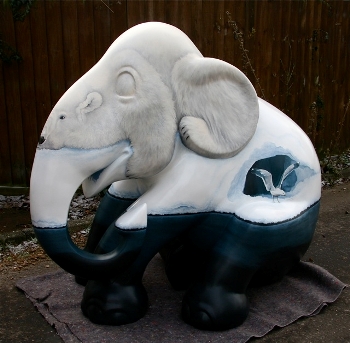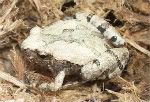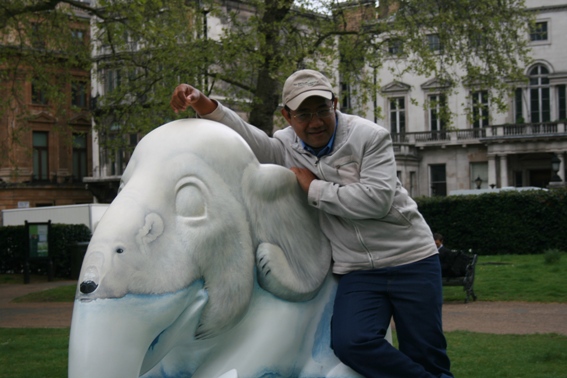Although urban Britain is not the native habitat of the Asian elephant, the well-loved pachyderm has invaded London for the summer. Raising awareness and funds for the threatened Asian elephant, 250 fiberglass statues by different artists are being displayed all over London.
At the end of the summer the elephants will be auctioned off. All the proceeds from the art parade will go to Elephant Family, a conservation organization whose mission is to save the Asian Elephant from extinction.
While some of the elephants are purely decorative, many have conservation-messages mixed in. For example, conservation organization Fauna and Flora International (FFI)’s elephant, known as Nanook, has the image of a polar bear on it, linking deforestation in Southeast Asia to the survival of both the Asian elephant and the polar bear since rainforest destruction produces significant carbon emissions. The elephant was painted by Martin Aveling.
 FFI elephant in London’s Elephant Parade. Photo courtesy of: FFI. |
The elephant parade has also brought elephant conservation heroes to London, including recent Goldman Environmental Prize winner, Tuy Sereivathana, who successfully ended elephant-human conflict in his home-country Cambodia.
“The elephant is a flagship species,” Sereivathana told mongabay.com while visiting London. “To conserve the elephant, we have to think about their habitat (they need large forest), so other species can survive in the habitat. In case of water sources during the dry season, elephants make water holes by trampling, so other wildlife also use the water source. Elephants spread out seeds of trees in forest.”
Sereivathana heads the Cambodian Elephant Conservation Group, which is co-managed by Fauna and Flora International.
Asian elephants (Elephas maximus) are currently listed as Endangered by the IUCN Red List. Conservationists believe the global population has been cut in half in three elephant generations largely due to habitat loss and poaching.
Tuy Sereivathana with FFI’s elephant statue in London. Photo by: Rachel Austin/FFI.
Related articles
One man’s mission to save Cambodia’s elephants

(05/17/2010) Since winning the prestigious 2010 Goldman Environmental Prize in Asia, Tuy Sereivathana has visited the US and Britain, even shaking hands with US President Barack Obama, yet in his home country of Cambodia he remains simply ‘Uncle Elephant’. A lifelong advocate for elephants in the Southeast Asian country, Sereivathana’s work has allowed villagers and elephants to live side-by-side. Working with Fauna and Flora International (FFI) he has successfully brought elephant-killing in Cambodia to an end. As if this were not enough, Sereivathana has helped curb the destruction of forests in his native country and built four schools for children who didn’t previously have formal education opportunities.
Conservation organization purchases vital wildlife corridor for elephants in India
(01/11/2010) On Christmas Eve, the Wildlife Trust of India (WTI) and the International Fund for Animal Welfare (IFAW) completed a transaction to purchase an important wildlie corridor used by over a thousand Asian elephants (Elephas maximus). The 25.4 acre Kollegal Elephant Corridor was under private ownership, but may now be incorporated into adjacent Biligiri Ranganswamy Temple Wildlife Sanctuary (IFAW).
Frogs species discovered living in elephant dung

(06/10/2009) Three different species of frogs have been discovered living in the dung of the Asian elephant in southeastern Sri Lanka. The discovery—the first time anyone has recorded frogs living in elephant droppings—has widespread conservation implications both for frogs and Asian elephants, which are in decline. “I found the frogs fortuitously during a field study about seed dispersal by elephants,” Ahimsa Campos-Arceiz, a research fellow from the University of Tokyo, told Monagaby.com.
High ivory prices in Vietnam drive killing of elephants in Laos, Cambodia
(02/19/2009) Indochina’s remaining elephants are at risk from surging ivory prices in Vietnam, according to a new report from the wildlife trade monitoring network TRAFFIC.
Population of Asian elephants discovered in Malaysian park

(01/15/2009) A population of 631 Asian elephants has been documented in Malaysia’s Taman Negara National Park, reports the Wildlife Conservation Society (WCS). The population may be the largest in Southeast Asia. Scientists from WCS and Malaysia’s Department of Wildlife and National Parks (DWNP) counted elephant dung piles to estimate the protected area’s population size. There were no previous scientific population surveys for elephants in the park.
